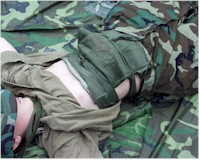|
Medical Education Division |
Operational Medicine 2001
Field Medical Service School
Student Handbook

|
ABDOMINAL INJURIES FMST
0408 16
Dec 99
TERMINAL
LEARNING OBJECTIVES: 1. Given an abdominal injury in a combat environment and standard Field Medical Service Technician supplies and equipment, manage abdominal injuries, per the references. (FMST. 04.09) ENABLING
LEARNING OBJECTIVES: 1.
Without the aid of reference materials and given a list, identify the
locations of major organs within the abdomen, per the student handbook.
(FMST.04.09a) 2.
Without the aid of reference materials and given a list of signs and
symptoms, select the signs which identify traumatic abdominal injuries, per the
student handbook. (FMST.04.09b) 3.
Without the aid of reference materials and given a list of treatments and
a list of abdominal 4.
Without the aid of reference materials and given the FMST MOLLE Medic bag
and a simulated casualty with an abdominal injury, identify, treat and monitor
the casualty, per the student handbook. (FMST.04.09d) OUTLINE: A. GENRAL ANATOMY
a. Right Upper Quadrant (# 1 in Fig - 1) Contains
the liver, right kidney, colon, pancreas, and the gallbladder. b. Right Lower Quadrant (# 2 in Fig - 1) Contains
the colon, small intestines, major artery and vein for the right leg, the right
ureter, and the appendix. c. Left Upper Quadrant (# 3 in Fig - 1) Contains
the spleen, left kidney, stomach, colon, and the pancreas. d. Left Lower Quadrant (# 4 in Fig -1) Contains
the colon, small intestines, major artery and vein for the left leg, and the left
ureter. 4.
The abdominal organs can be classified as either "Hollow" or
"Solid" organs, depending on their functions. a.
Hollow - tubes through which materials pass (stomach, intestines, ureters
and bladder) 1.
food that is in the process of being digested 2.
urine that is being passed to the bladder for release 3.
bile b.
Solid - solid masses of tissue (liver, spleen, pancreas and kidneys) 1.
much of the chemical work of the body takes place 2.
highly vascular
Figure
1 - Diagram of the Four Quadrants of the Abdomen B. TYPES OF INJURIES
C. SIGNS AND SYMPTOMS
a. Pain to the area b. Guarding from pain c. Elevated heart rate d. Signs of shock e. Distended abdomen f. Obvious bruising g. Abdomen firm or rigid on palpation h. Hypoactive or absent bowel sounds i. Hypotension
a. Obvious entry wound b. Bleeding c. Bowel evisceration (a portion of the bowel extrudes from the abdominal cavity) d. Guarding e. Signs of shock f. Pain to the area g. Distended abdomen h. Abdomen may be distended or rigid on palpation i. Hypotension D. TREATMENT
a. Maintain the patientís ABC's b. Establish baseline vital signs c. Place in the supine position with knees slightly flexed d. Determine history e. Keep calm f. Treat for shock g. Do not strongly palpate abdomen h. CASEVAC immediately
a. Maintain the patientís ABC's b. Inspect sides and back for entry / exit wounds c. Apply dry, sterile dressing to open wounds d. Eviscerated bowels should be covered with sterile dressings soaked in normal saline e. Gently secure eviscerated bowel to avoid further damage f. Assume penetrations have reached peritoneum g. Treat for shock h. Do not probe for objects i. Penetrating objects still embedded should be left in place and protected with dressing j. CASEVAC immediately
REFERENCE
(S): 1. Emergency Care and Transportation of the Sick and Injured; Seventh Edition, 1998 Field Medical Service School
Approved for public release; Distribution is unlimited. The listing of any non-Federal product in this CD is not an endorsement of the product itself, but simply an acknowledgement of the source. Operational Medicine 2001 Home ∑ Military Medicine ∑ Sick Call ∑ Basic Exams ∑ Medical Procedures ∑ Lab and X-ray ∑ The Pharmacy ∑ The Library ∑ Equipment ∑ Patient Transport ∑ Medical Force Protection ∑ Operational Safety ∑ Operational Settings ∑ Special Operations ∑ Humanitarian Missions ∑ Instructions/Orders ∑ Other Agencies ∑ Video Gallery ∑ Phone Consultation ∑ Forms ∑ Web Links ∑ Acknowledgements ∑ Help ∑ Feedback
*This web version is provided by The Brookside Associates Medical Education Division. It contains original contents from the official US Navy NAVMED P-5139, but has been reformatted for web access and includes advertising and links that were not present in the original version. This web version has not been approved by the Department of the Navy or the Department of Defense. The presence of any advertising on these pages does not constitute an endorsement of that product or service by either the US Department of Defense or the Brookside Associates. The Brookside Associates is a private organization, not affiliated with the United States Department of Defense. |


